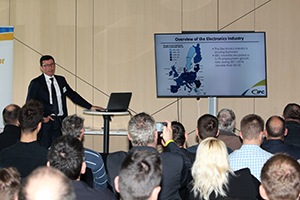By Chris Mitchell, IPC vice president of global government relations
[caption id="attachment_4678" align="alignleft" width="300"]
 IPC member company executives gathered in DC last week for a round of advocacy meetings.
IPC member company executives gathered in DC last week for a round of advocacy meetings.[/caption]
Top executives from electronics companies across the United States were in Washington, D.C., last week to call on the Trump administration and Congress to support policies that will drive the electronics industry’s future growth in North America and worldwide.
IPC’s government relations team works year-round to advance the industry’s interests in North America, Europe, and Asia. But policymakers are very interested in hearing directly from their constituents – the “real people” who are affected by their policy debates.
That is why IPC convenes events like I
MPACT Washington, D.C. 2019 and
IMPACT Europe, where industry leaders to come together and make our united voice heard in the halls of government.
One of the highlights of this year’s IMPACT Washington program was a new
report – commissioned by IPC and written by noted economist
Shawn DuBravac – which concluded that the USMCA would be a positive step for the electronics sector and should be approved by the U.S. Congress this year.
Attendees had a chance to hear directly from the USMCA study author and share their own thoughts on U.S.-Mexico-Canada trade with senior congressional staff who handle trade matters, as well as
Daniel Watson, the Deputy Assistant U.S. Trade Representative for North America and one of the chief negotiators for the USMCA.
As a follow-up, the House Ways and Means Committee has asked that we recommend individuals from the business community who may want to participate in hearings on USMCA. If such an opportunity interests you, please
contact me.
That’s just one example of how IPC works with our members to bring our advocacy efforts to life and have a real impact; and there are many more.
During the D.C. event, attendees also met with other leading policymakers to discuss the electronics supply chain, EPA regulations, and workforce education. As a group, the executives met with:
•
Eric Ueland, Deputy Director of the White House Domestic Policy Council, and
Scott Stump, Assistant Secretary for Technical, Career and Adult Education at the U.S. Department of Education, both of whom are interested in IPC’s growing
workforce education programs;
•
Mike Molnar, Director of the Office of Advanced Manufacturing (OAM) at the National Institute of Standards and Technology (NIST), who briefed us on the Trump administration’s
Strategy for American Leadership in Advanced Manufacturing and our industry’s role in it;
•
Henry Darwin, Acting Deputy Administrator, U.S. Environmental Protection Agency (EPA), who is working to reduce regulatory burdens and implement leaner, more efficient operations at the EPA;
• Majority and Minority staff of both the Senate Finance Committee and House Ways and Means Committee, who will oversee congressional consideration of the USMCA;
• Former Indiana senator
Joe Donnelly, who has worked with IPC and DOD on defense supply chain issues; and
• Former Virginia congressman
Tom Davis, a consummate Washington insider.
On Capitol Hill, members met with their own elected officials including Reps.
Jack Bergman (R-MI) and
Lance Gooden (R-TX), as well as influential staff members in the offices of Sens.
Bob Casey (D-PA),
John Cornyn (R-TX),
Ted Cruz (R-TX),
Dianne Feinstein (D-CA);
Gary Peters (D-MI),
Debbie Stabenow (D-MI),
Pat Toomey (D-PA), and Reps.
Lou Correa (D-CA);
John Larson (D-CT), and
Eric Swalwell (D-CA).
Member executives also had the opportunity to hear from Indiana Senator
Joe Donnelly, who praised electronics companies for helping to ensure the safety and success of U.S. military service members; and from former Virginia congressman
Tom Davis, a consummate Washington insider, who delved into the forces shaping the politics of 2019 and 2020.
Participating member companies included
Calumet Electronics of Calumet, Mich.;
Chemcut of State College, Penn.;
Eagle Circuits of Dallas, Tex.;
Juki Automation Systems of Fremont, Calif.;
Heller Industries of Florham, N.J.;
Lockheed Martin of Orlando, Fla.;
Summit Interconnect of Anaheim, Calif.;
STI Electronics of Madison, Ala.;
TTM Technologies of Sterling, Va.;
Uyemura International of Ontario, Calif.;
VirTex Enterprises of Austin, Tex.; and
Zentech Manufacturing of Windsor Mill, Md.
To all who participated, thank you! Your active engagement has made a huge difference in advancing our industry’s future success. We’ll be in touch with follow-up activities.
To those of you who missed this opportunity but want to be in the loop on IPC’s government relations efforts going forward, please
check out these options and let us know your interests. We have a robust, year-round agenda of advocacy activities, and your participation in those efforts would be welcomed and valuable.
VIEW PHOTO GALLERY
 thousands of industry volunteers. Their expertise, insights, and support are essential to the success of IPC’s standards, and it is always great to see IPC leaders come together, especially when we have the opportunity to honor those who have made significant contributions to the industry.
2. IPC standards are key to helping member stay on top of environmental and supply-chain regulations. IPC standards committees are on the front lines of understanding and complying with the dizzying array of ever-changing environmental regulations that affect global and domestic supply chains. The Supplier Declaration Subcommittee and the IPC-175x task groups are working to ensure that our members are able to comply with these regulations in the most efficient manner by building flexible frameworks and data exchange models.
3. Industry is tackling microvia reliability concerns. Industry representatives discussed concerns related to microvia reliability and agreed to share the work of understanding the scope of the issue and advancing solutions and standards. Interested in getting involved in this important work? IPC Contact: Chris Jorgensen
4. IPC task group moves closer to final conflict minerals data exchange standard. The IPC 2-18H task group addressed comments received on the standard’s final draft, and now it plans to vote on a final revision this summer. IPC will be working to see that this standard is recognized by the European Commission as an applicable “supply chain due diligence scheme.” Separately, IPC is in talks with the European Partnership for Responsible Minerals (EPRM) to promote collaboration on this issue.
5. The U.S. Executive Agent (EA) for PCBs affirmed the importance of “trusted supplier” programs. IPC, the EA, and the defense contractor community worked together to create a “trusted supplier” standard, known as IPC-1791. Based on this standard, IPC is now providing validation services for members of the IPC-1791 Qualified Manufacturers List (QML). The EA detailed efforts to grow the importance and value of the 1791 program, which coincides with wider efforts within the U.S. DoD to ensure reliable supply chains. To learn more about IPC-1791, contact our colleague Randy Cherry.
6. Workforce shortage remains top industry challenge. No matter where we travel, we hear the same refrain from industry colleagues: The shortage of workers is restraining growth and opportunity. IPC is working to address this issue through our jobs task analysis, credentialing, and STEM education programs. The IPC GR team is advocating for public-private career, technical and adult education (CTE) programs, as well as the expansion of industry-recognized apprenticeship programs. IPC members are also undertaking their own innovative programs. Be sure to tell us about your company’s efforts to bolster the workforce so that we can recognize and share them with the rest of industry. Also, don’t forget to mentor or be mentored in IPC’s Emerging Engineer Program.
7. IPC Government Relations poised to better support standards committees. IPC’s standards committees are taking on many daunting challenges, some of which are related directly or indirectly to public policy. For example, the Halogen-Free Materials Subcommittee is beginning the revision of a seminal white paper on halogen-free alternatives, which is related to EPA’s implementation of the Lautenberg Chemical Safety Act. Halogenated, flame-retardant chemicals like decabromodiphenyl ether (decaBDE) and tetrabromobisphenol A (TBBPA) are being considered for risk evaluations and risk-management strategies. IPC’s Government Relations team is working to provide policy expertise to this committee and others that are undertaking equally meaningful projects.
Check out the photos from this event, and please don’t hesitate to reach out to us about the interplay of IPC standards and public policy, or any government relations matter.
thousands of industry volunteers. Their expertise, insights, and support are essential to the success of IPC’s standards, and it is always great to see IPC leaders come together, especially when we have the opportunity to honor those who have made significant contributions to the industry.
2. IPC standards are key to helping member stay on top of environmental and supply-chain regulations. IPC standards committees are on the front lines of understanding and complying with the dizzying array of ever-changing environmental regulations that affect global and domestic supply chains. The Supplier Declaration Subcommittee and the IPC-175x task groups are working to ensure that our members are able to comply with these regulations in the most efficient manner by building flexible frameworks and data exchange models.
3. Industry is tackling microvia reliability concerns. Industry representatives discussed concerns related to microvia reliability and agreed to share the work of understanding the scope of the issue and advancing solutions and standards. Interested in getting involved in this important work? IPC Contact: Chris Jorgensen
4. IPC task group moves closer to final conflict minerals data exchange standard. The IPC 2-18H task group addressed comments received on the standard’s final draft, and now it plans to vote on a final revision this summer. IPC will be working to see that this standard is recognized by the European Commission as an applicable “supply chain due diligence scheme.” Separately, IPC is in talks with the European Partnership for Responsible Minerals (EPRM) to promote collaboration on this issue.
5. The U.S. Executive Agent (EA) for PCBs affirmed the importance of “trusted supplier” programs. IPC, the EA, and the defense contractor community worked together to create a “trusted supplier” standard, known as IPC-1791. Based on this standard, IPC is now providing validation services for members of the IPC-1791 Qualified Manufacturers List (QML). The EA detailed efforts to grow the importance and value of the 1791 program, which coincides with wider efforts within the U.S. DoD to ensure reliable supply chains. To learn more about IPC-1791, contact our colleague Randy Cherry.
6. Workforce shortage remains top industry challenge. No matter where we travel, we hear the same refrain from industry colleagues: The shortage of workers is restraining growth and opportunity. IPC is working to address this issue through our jobs task analysis, credentialing, and STEM education programs. The IPC GR team is advocating for public-private career, technical and adult education (CTE) programs, as well as the expansion of industry-recognized apprenticeship programs. IPC members are also undertaking their own innovative programs. Be sure to tell us about your company’s efforts to bolster the workforce so that we can recognize and share them with the rest of industry. Also, don’t forget to mentor or be mentored in IPC’s Emerging Engineer Program.
7. IPC Government Relations poised to better support standards committees. IPC’s standards committees are taking on many daunting challenges, some of which are related directly or indirectly to public policy. For example, the Halogen-Free Materials Subcommittee is beginning the revision of a seminal white paper on halogen-free alternatives, which is related to EPA’s implementation of the Lautenberg Chemical Safety Act. Halogenated, flame-retardant chemicals like decabromodiphenyl ether (decaBDE) and tetrabromobisphenol A (TBBPA) are being considered for risk evaluations and risk-management strategies. IPC’s Government Relations team is working to provide policy expertise to this committee and others that are undertaking equally meaningful projects.
Check out the photos from this event, and please don’t hesitate to reach out to us about the interplay of IPC standards and public policy, or any government relations matter.





